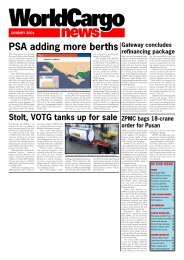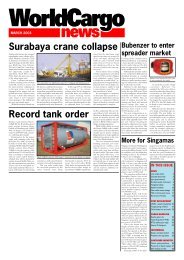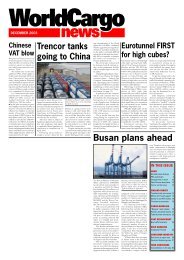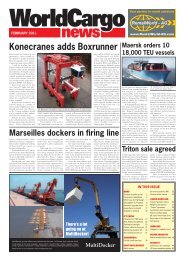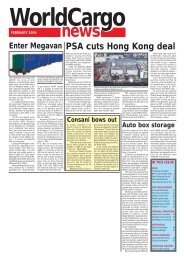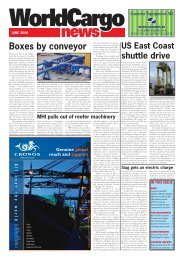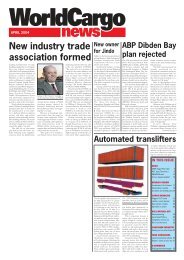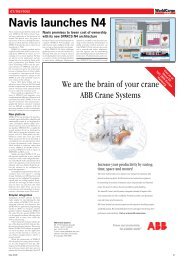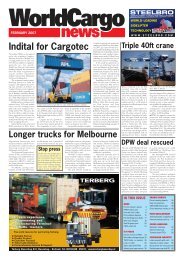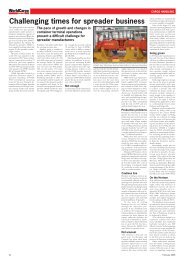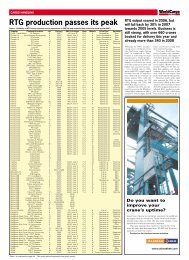Tanjung Priok super port - WorldCargo News Online
Tanjung Priok super port - WorldCargo News Online
Tanjung Priok super port - WorldCargo News Online
You also want an ePaper? Increase the reach of your titles
YUMPU automatically turns print PDFs into web optimized ePapers that Google loves.
<strong>WorldCargo</strong><br />
news<br />
Pintsch Bubenzer charting a new path<br />
Pintsch Bubenzer is investing in a<br />
new generation of brakes while<br />
developing MYPort into a crane<br />
and terminal service company<br />
Pintsch Bubenzer GmbH (PB) recently<br />
held a 10th anniversary celebration<br />
for its Malaysian subsidiary<br />
PB MyPort Sdn Bhd (PBMY).<br />
In its short history MyPort has<br />
grown from a strategic Singapore<br />
branch office to what PB describes<br />
as a “global centre for crane braking<br />
systems.”<br />
PBMY now has 32 employees,<br />
including eight service engineers<br />
and eight mechanical and<br />
electrical engineers - more service<br />
personnel than PB has in Germany<br />
- and is extending its operations<br />
well beyond brakes. It<br />
operates from two facilities, a<br />
training centre at <strong>Tanjung</strong> Pelepas<br />
and a new building at nearby<br />
Gelang Patah.<br />
This requires considerable investment,<br />
and raises the question<br />
whether the Schaltbau Group,<br />
which owns PB through Pintsch<br />
Bamag, has a wider strategy that<br />
may eventually lead to starting<br />
brakes production in Malaysia.<br />
PB’s managing director<br />
Markus Topp said, however, that<br />
<br />
WWW.SUMINISTROSPORTUARIOS.COM<br />
<br />
<br />
<br />
<br />
<br />
<br />
<br />
■ Hydraulic Buffers<br />
■ Dampers<br />
■ Industrial Brakes<br />
■ Couplings<br />
■ Thrusters<br />
■ Brake Drums<br />
■ Brake Discs<br />
■ Rail Clamps<br />
■ Guide Rollers<br />
■ Telescopic Forks<br />
Please visit us at<br />
TOC Europe 2013<br />
Rotterdam, June 25-27<br />
Stand No. E66<br />
<br />
<br />
<br />
<br />
<br />
<br />
High quality by engineering & production<br />
Specialist for brake- and drive technology<br />
MADE i n GERMANY<br />
NEW<br />
TURBO - Brake - System<br />
brake apply time approx.:<br />
150 ms<br />
instead of 350-450 ms<br />
Quality ■ Safety ■ Efficiency<br />
the company is committed to<br />
maintaining manufacturing in<br />
Germany. The company wants to<br />
be at the forefront of developing<br />
new braking technology, and Topp<br />
does not believe this is possible if<br />
manufacturing is sent offshore.<br />
Cost is of course im<strong>port</strong>ant,<br />
but PB has addressed it by investing<br />
in capital equipment to make<br />
manufacturing less labour-intensive,<br />
including machinery that<br />
performs multiple processes, and<br />
reconfiguring its factory so one<br />
operator controls two machines.<br />
This strategy requires capital<br />
and commitment, not just to invest<br />
in new equipment, but to<br />
develop the sup<strong>port</strong>ing labour<br />
force. PB needs workers with different<br />
skills than previously, and<br />
has actively engaged local universities<br />
and polytechnics to ensure<br />
it positions itself as an attractive<br />
option for young people.<br />
New centre<br />
PB has just opened a new research<br />
and development centre near its<br />
manufacturing facility in Kirchen-<br />
Wehbach. It will be able to meet<br />
increasing demand for documented<br />
tests as well as producing<br />
new products. It is equipped with<br />
dyno stands for high speed brakes<br />
and test benches for storm and<br />
emergency brakes.<br />
For the container crane market,<br />
the first new product will be<br />
an electro mechanical wheel brake,<br />
scheduled for release later this year.<br />
Current wheel brakes are hydraulically<br />
released and terminal operators<br />
would like to eliminate<br />
hydraulics as far as possible. PB has<br />
developed several prototypes and<br />
is now finalising a design to launch<br />
on the market later this year.<br />
Go with the cranes<br />
PB’s strategy with MyPort, said<br />
Topp, is driven by the need to take<br />
sales and service directly to the<br />
Asian market, which is now too<br />
big to be handled effectively out<br />
of Germany. In 2011 the company<br />
acquired 95% of PBMY and last<br />
year opened an office in Shanghai.<br />
It also has a US service and<br />
training centre (PBUS) in<br />
Flemington, New Jersey.<br />
Topp explains that PB has developed<br />
a policy of “know-how<br />
transfer” so local companies can<br />
provide a full service offering.<br />
Dealing with brake issues requires<br />
a wide range of skills. Brake wear<br />
is frequently caused by alignment<br />
RÖMER Fördertechnik GmbH<br />
The apply time of all our electro-hydraulically operated<br />
industrial brake systems can significantly be reduced to<br />
150 ms due to a special control of the electro-hydraulical<br />
thruster system.<br />
Stand E 24<br />
25.-27.06.2013<br />
issues in rope drum drive systems<br />
and, on some cranes, structural<br />
deflection in the machinery house<br />
floor. PBMY has built up considerable<br />
expertise, including a laser<br />
alignment system, to troubleshoot<br />
and fix braking problems. This includes<br />
selecting couplings and<br />
other components that match the<br />
wear characteristics of the crane<br />
as well as the technical specifications<br />
of the drive system.<br />
In the frame<br />
At a component level PBMY and<br />
PBUS are equipped and certificated<br />
to rebuild brakes and thrusters, so<br />
components no longer have to be returned<br />
to Germany for this service.<br />
This has enabled them to enter<br />
service contracts and “frame<br />
agreements” covering servicing<br />
and rebuilding of older brakes.<br />
PBUS has a frame agreement with<br />
the Port of Houston Authority<br />
and PBMY has a five-year agreement<br />
with North<strong>port</strong> and a 2-year<br />
agreement covering PSA Singapore’s<br />
huge crane fleet. Brakes that<br />
are 15 years old, including brakes<br />
from other suppliers, are removed<br />
from service and rebuilt, tested and<br />
certified locally.<br />
PBMY is now moving beyond<br />
brakes and evolving into a wider<br />
service company. It is a partner<br />
with Siemens in the Siemens-<br />
My<strong>port</strong> Regional Crane Training<br />
Centre at <strong>Tanjung</strong> Pelepas, which<br />
can train and certify a technician<br />
in Siemens drives and PLCs. It also<br />
offers gearbox rebuilds on Stiebel<br />
gearboxes, which are used in the<br />
Siemens ECO RTG system.<br />
PBMY’s managing director<br />
Suzannah E Jamain said drive refurbishment<br />
has huge potential.<br />
There are many old GE drives in<br />
Malaysia on cranes from Impsa,<br />
Doosan, Favelle Favco and Muhibaha.<br />
PBMY has worked with terminals<br />
to keep these up and running,<br />
but many are now at the<br />
point where they need replacing.<br />
PBMY is also working further<br />
afield, and recently completed a<br />
project to retrofit two Mitsubishi<br />
STS cranes in Dubai, replacing GE<br />
DC drives with a Siemens system.<br />
In Malaysia, PBMY is moving into<br />
the container yard, where it offers<br />
installation and commissioning for<br />
the Stemmann Technik E-RTG<br />
conductor bar system, and it is<br />
developing a DGPS-based container<br />
position system and wireless<br />
LAN installation and sup<strong>port</strong>.<br />
SOS message<br />
The first two cranes with the SOS<br />
electro mechanical snag and over-<br />
CARGO HANDLING<br />
North<strong>port</strong> Klang is fitting its new STS cranes with the Pintsch Bubenzer<br />
Malmedie SOS snag load protection system<br />
load prevention system in Asia are<br />
now undergoing commissioning<br />
at North<strong>port</strong> in Port Klang, Malaysia.<br />
The cranes are the first of<br />
five North<strong>port</strong> has ordered from<br />
Hyundai Samho. North<strong>port</strong>’s assistant<br />
general manager, equipment<br />
and maintenance, G<br />
Sundaraja Perumal believes that<br />
there are two main benefits from<br />
the SOS system: a reduction in<br />
crane weight by eliminating hydraulic<br />
snag cylinders at the boom<br />
tip; and reduced maintenance.<br />
The first two cranes will operate<br />
on a quay with a wheel limit<br />
of 40t per metre. North<strong>port</strong><br />
wanted twin lift capability and its<br />
consultant, Casper Phillips & Associates,<br />
designed a crane with a<br />
55t SWL over the 40m outreach<br />
weighing just 1250t (with 10<br />
wheels per corner to spread the<br />
load). Every op<strong>port</strong>unity to save<br />
weight was im<strong>port</strong>ant.<br />
Most snag events at North<strong>port</strong><br />
actually happen on smaller, older<br />
vessels with damaged cell guides.<br />
North<strong>port</strong> has hydraulic anti snag<br />
systems on other cranes and<br />
Sundaraja said they require regular<br />
maintenance, particularly as<br />
they age and start to leak. He<br />
would like to eliminate hydraulics<br />
wherever possible and, as well<br />
as the SOS system, the new cranes<br />
will have a mechanical screw type,<br />
trim, list and skew system.<br />
Brake monitoring<br />
Another area where Sundaraja<br />
expects significant benefits is having<br />
the brake monitoring system<br />
integrated with the main crane<br />
monitoring system (CMS). PB’s<br />
latest computer brake monitoring<br />
system, called CMB2, connects to<br />
the crane PLC via Profibus and is<br />
pre-integrated with the CMS before<br />
the crane is delivered.<br />
Sundaraja said North<strong>port</strong> has<br />
changed its approach to buying<br />
cranes. It the past it relied on the<br />
OEM to engineer the drive, but<br />
now it requires the drive supplier<br />
to engineer, install and commission<br />
the drive itself. It is taking a<br />
similar approach with brakes and<br />
PB is designing the whole braking<br />
system and maintaining it under<br />
its existing 5-year agreement.<br />
North<strong>port</strong> previously tried to<br />
outsource maintenance to a general<br />
service company, but has not<br />
been happy with some of the results.<br />
“What we are doing now, said<br />
Sundaraja, “is identifying the critical<br />
components where we want<br />
the component suppliers to be<br />
involved in regular inspections and<br />
maintenance.” ❏<br />
Pintsch Bubenzer is developing an electro mechanical wheel brake for long<br />
travel applications<br />
Replacement<br />
for -er<br />
www.rft-germany.com<br />
72<br />
May 2013



